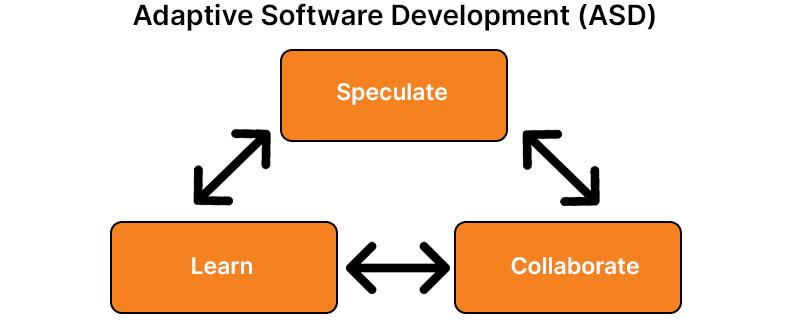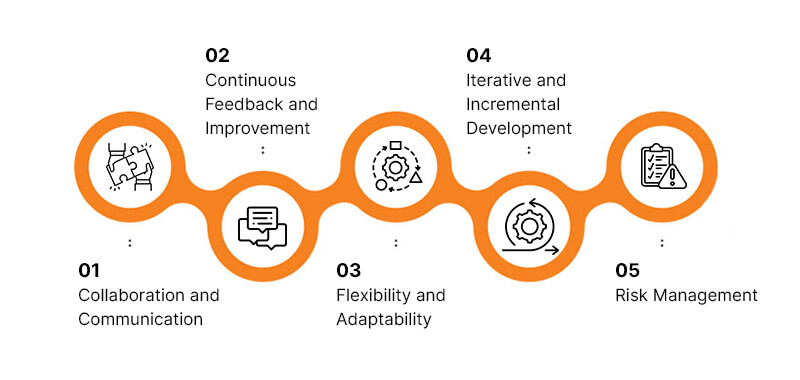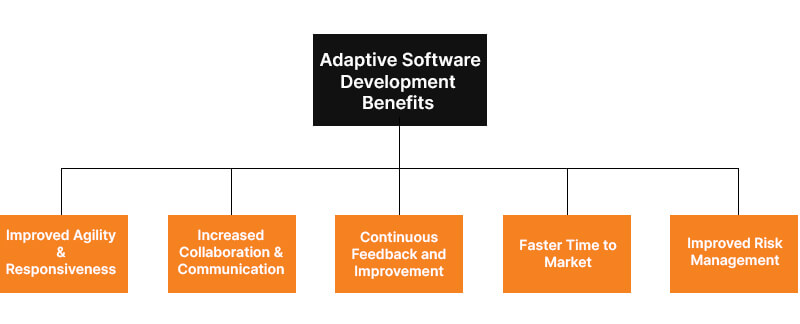Have you ever been a part of a software development project that ended up going off track or failing to meet the needs of end users? Traditional software development methodologies can be rigid, inflexible, and challenging to adapt to changing requirements or circumstances. That’s where adaptive software development (ASD) comes in. ASD is a software development methodology emphasizing flexibility, collaboration, and continuous feedback. Unlike traditional approaches, which rely on strict planning and a linear approach, ASD is designed to adapt to changing requirements and circumstances.
By prioritizing collaboration, communication, and flexibility, ASD helps businesses deliver software that meets end-users’ needs and responds quickly to changing market conditions. In this article, we’ll explore the benefits of adaptive software development, as well as common pitfalls to watch out for when implementing this approach.
What is Adaptive Software Development?

Adaptive software development (ASD) is a software development methodology that emphasizes flexibility, collaboration, and continuous feedback. Unlike traditional software development approaches, such as the Waterfall model, which relies on strict planning and a linear approach, ASD is designed to adapt to changing requirements and circumstances.
Jim Highsmith first introduced ASD in the late 1990s as a response to the limitations of traditional scaleup software development methodologies. Highsmith argued that traditional approaches needed to be more flexible and inflexible, often resulting in failed projects and missed deadlines. ASD, on the other hand, prioritizes communication, collaboration, and flexibility, making it well-suited to today’s dynamic business environment.
Key Principles of Adaptive Software Development
So, what are the key principles of adaptive software development? Let’s take a look:

1. Collaboration and Communication
One of the core principles of ASD is collaboration and communication. ASD emphasizes involving stakeholders, such as end-users and project sponsors, throughout the development process. This ensures everyone is on the same page and the project is aligned with the scale-up’s goals and objectives.
2. Continuous Feedback and Improvement
Another key principle of ASD is continuous feedback and improvement. ASD prioritizes iteration and experimentation, with teams constantly testing and refining the software based on user feedback. This approach ensures that the software continuously evolves to meet changing needs and requirements.
3. Flexibility and Adaptability
ASD is designed to be flexible and adaptable, with teams able to pivot and adjust to changing circumstances. This approach allows teams to respond quickly to new opportunities or challenges without being constrained by rigid project plans.
4. Iterative and Incremental Development
ASD uses an iterative and incremental approach to software development, with teams delivering small, incremental improvements over time. This allows teams to validate assumptions, test hypotheses, and adjust, ensuring that the final product meets the end-users’ needs.
5. Risk Management
Finally, ASD emphasizes risk management, with teams proactively identifying and mitigating potential risks throughout development. This approach helps ensure that the project stays on track and that potential roadblocks are addressed before they become significant issues.
Find out everything about hiring Dedicated Product Development Teams for Projects of Any Scale and Complexity.
Benefits of Adaptive Software Development
So, why should businesses consider using adaptive software development? Here are some of the key benefits:

1. Improved Agility and Responsiveness
ASD is designed to be agile and responsive, making it well-suited to today’s fast-paced business environment. By prioritizing flexibility and adaptability, teams can respond quickly to changing needs and requirements without being constrained by rigid project plans.
2. Increased Collaboration and Communication
ASD prioritizes collaboration and communication, ensuring all stakeholders are involved throughout development. This approach helps ensure everyone is on the same page and that the final product meets the end-users’ needs.
3. Continuous Feedback and Improvement
ASD prioritizes continuous feedback and improvement, with teams constantly testing and refining the software based on user feedback. This approach helps ensure the software continuously evolves to meet changing needs and requirements.
4. Faster Time to Market
ASD’s iterative and incremental approach to software development allows teams to deliver small, incremental improvements over time. This approach helps ensure the software is delivered to end-users faster without sacrificing quality.
5. Improved Risk Management
Finally, adaptive software development helps improve risk management, with teams proactively identifying and mitigating potential risks throughout the development process. This approach helps ensure that potential roadblocks are addressed before they become major issues, helping to keep the project on track.
How to Implement Adaptive Software Development
So, how can businesses implement adaptive software development? Here are some tips:

1. Build a Collaborative Culture
To implement ASD successfully, businesses must build a culture of collaboration and communication. This involves involving stakeholders, such as end-users and project sponsors, throughout the development process.
2. Prioritize Continuous Feedback and Improvement
ASD prioritizes continuous feedback and improvement, with teams constantly testing and refining the software based on user feedback. To implement ASD, businesses must prioritize this approach, ensuring that feedback is incorporated throughout the development process.
3. Embrace Flexibility and Adaptability
ASD is designed to be flexible and adaptable, with teams able to pivot and adjust to changing circumstances. To implement ASD successfully, businesses must embrace this approach, allowing teams to respond quickly to new opportunities or challenges.
4. Use an Iterative and Incremental Approach
ASD uses an iterative and incremental approach to software development, with teams delivering small, incremental improvements over time. To implement ASD successfully, businesses must embrace this approach, breaking the scaleup software development process into smaller, more manageable chunks.
5. Invest in Risk Management
Finally, businesses must invest in risk management, proactively identifying and mitigating potential risks throughout development. This involves identifying potential roadblocks early on and addressing them before they become major issues.
Pitfalls of Adaptive Software Development
While adaptive software development (ASD) has many benefits, there are also potential pitfalls that businesses should be aware of when implementing this approach. Here are some common pitfalls to watch out for:
1. Lack of Structure
One of the key features of ASD is its flexibility and adaptability, but this can also be a drawback if there is not enough structure in place. On the other hand, with a clear plan or roadmap, teams may be able to stay on track and prioritize tasks effectively.
To avoid this, businesses should ensure that there is still some structure and scale-up in place, even as they embrace the iterative and incremental approach of ASD. This can include setting clear goals, creating a high-level plan, and establishing checkpoints or milestones throughout development.
2. Poor Communication
ASD relies heavily on collaboration and communication, which can be challenging if teams are not communicating effectively. If team members are working in silos or not sharing information, it can lead to misunderstandings, delays, or even project failure.
To avoid this, businesses should prioritize communication throughout the development process. This can include regular team meetings, daily stand-ups, and frequent check-ins with stakeholders or end-users. It’s also essential to establish clear communication channels, such as using collaboration tools or establishing a central repository for project information.
3. Scope Creep
ASD is designed to be adaptable, but this can also lead to scope creep if no clear boundaries exist. With a clear understanding of what features or functionality are within scope, teams may be able to manage expectations or prioritize tasks effectively.
To avoid this, businesses should be clear about the project’s scope from the outset. This can include defining what features or functionality is in scope, establishing a timeline or roadmap for the project, and regularly revisiting the scope to ensure it aligns with business goals and end-user needs.
4. Lack of Commitment
ASD requires a certain level of commitment from all team members, including stakeholders, end-users, and developers. If team members are not fully invested in the project or do not have buy-in from upper management, it can be challenging to implement ASD successfully.
To avoid this, businesses should hire dedicated software developers and ensure that all team members are committed to the project and understand the benefits of ASD. This can include training or education on ASD, involving stakeholders and end-users throughout the development process, and setting clear expectations for all team members.
Final Words
Adaptive software development offers many benefits to businesses looking to deliver software that meets end-users’ needs and responds to changing market conditions. By prioritizing this, companies can deliver high-quality software that drives success. First, however, it’s essential to be aware of the potential pitfalls of ASD. Then, by addressing these challenges, businesses can successfully implement ASD and achieve their goals.
If you’re considering implementing adaptive software development, outsourcing your software development needs to a specialized provider can effectively take advantage of this approach while minimizing risk and ensuring quality. With the right partner, you can harness the power of ASD to deliver software that meets the needs of your business and end-users, all while staying ahead of the competition.
Get access to the top talent customized to your needs.
Hire Our Teams Now
Summary
Kickstart Your Project With Us!
Popular Posts
CONTACT US
Let's Build Your Agile Team.
Experience Netsmartz for 40 hours - No Cost, No Obligation.
Connect With Us Today!
Please fill out the form or send us an email to







